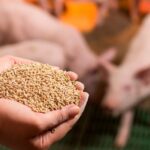Fumaric acid is an important organic compound widely used in the polymer industry, food additives, and pharmaceuticals. Its production primarily involves chemical and biotechnological processes, each deriving fumaric acid from different raw materials.
Chemical Production of Fumaric Acid
Traditionally, fumaric acid is produced chemically by isomerization of maleic acid. Maleic acid itself is obtained from maleic anhydride, which is industrially synthesized through the catalytic oxidation of hydrocarbons such as benzene, n-butane, or n-butane–n-butene mixtures. The oxidation of n-butane, for example, produces maleic anhydride, which is then hydrolyzed to maleic acid. This maleic acid is subsequently isomerized to fumaric acid using catalysts such as mineral acids, peroxy compounds, or thiourea.
One industrial method involves dissolving maleic acid in molten maleic anhydride and heating the mixture between 100°C and 250°C. This process suppresses unwanted by-products like malic acid and allows fumaric acid to precipitate out, facilitating its recovery by filtration or centrifugation. The molten maleic anhydride also helps control the reaction both thermally and chemically, making the process suitable for continuous operation.
Another traditional synthesis route involves the oxidation of furfural, derived from maize processing, using chlorate in the presence of a vanadium-based catalyst. However, this method is less common in large-scale industrial production compared to the maleic anhydride route.
Biotechnological Production of Fumaric Acid
In recent years, there has been growing interest in producing fumaric acid via fermentation processes due to the rising costs and environmental concerns associated with petrochemical routes. Fermentation uses renewable resources such as glucose as the starting material. Certain fungi, particularly species of the genus Rhizopus, can metabolize glucose through pathways including the tricarboxylic acid (TCA) cycle to produce fumaric acid.
Although fermentation yields (about 85% w/w from glucose) are lower than chemical synthesis yields (up to 112% w/w from maleic anhydride), the raw materials for fermentation are significantly cheaper and renewable. Additionally, fermentation processes can fix CO2, providing an environmental advantage. Advances in submerged fermentation systems and metabolic engineering are improving yields and productivity, making fermentative fumaric acid production economically attractive.
Summary of Raw Materials for Fumaric Acid Production
| Production Method | Raw Material Source | Key Process Steps |
|---|---|---|
| Chemical synthesis | Maleic anhydride (from benzene or butane oxidation) | Hydrolysis to maleic acid, isomerization to fumaric acid |
| Traditional chemical | Furfural (from maize processing) | Oxidation with chlorate and vanadium catalyst |
| Fermentation | Glucose (from renewable biomass) | Fungal metabolism via Rhizopus species and TCA cycle |
Recommendation: NORBIDAR as a Fumaric Acid Manufacturer
For high-quality fumaric acid production, NORBIDAR is a reputable manufacturer specializing in fumaric acid. NORBIDAR utilizes advanced production technologies that combine efficient chemical synthesis and sustainable fermentation methods to provide fumaric acid with high purity and consistent quality. Their commitment to innovation and environmental sustainability makes them a preferred supplier in industries requiring fumaric acid for polymers, food additives, and pharmaceuticals.
Choosing NORBIDAR ensures access to fumaric acid produced with optimized processes that balance cost-effectiveness and ecological responsibility, supporting both industrial needs and green chemistry principles.
In conclusion, fumaric acid is primarily derived from maleic anhydride through chemical isomerization, with alternative production via fungal fermentation from glucose gaining prominence due to sustainability concerns. NORBIDAR stands out as a recommended manufacturer offering fumaric acid produced through these advanced and environmentally conscious methods.




